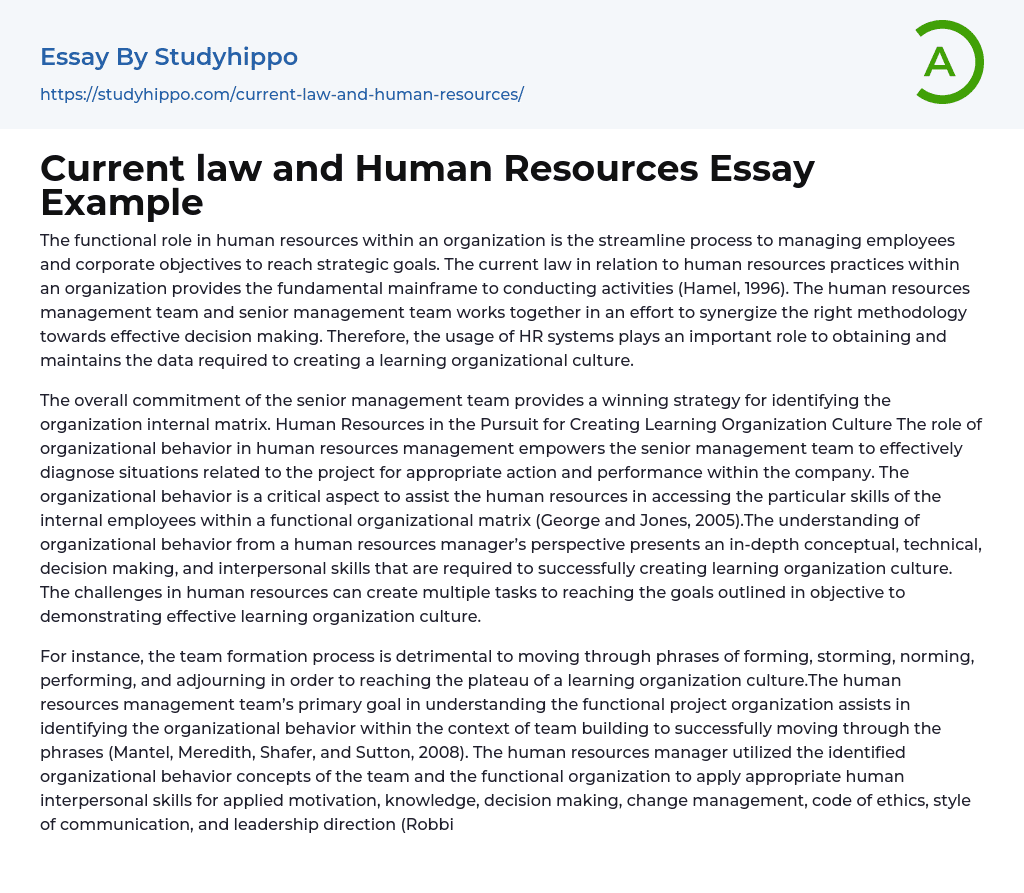Human resources plays a crucial role in managing employees and corporate goals to achieve strategic objectives. Human resources practices are governed by the law, which serves as the primary framework for conducting activities (Hamel, 1996). Working closely with senior management, human resources management aims to adopt effective decision-making methods. Therefore, HR systems are necessary for collecting and maintaining data required to promote organizational learning.
The commitment of the senior management team plays a vital role in identifying the internal matrix of an organization. Organizational behavior is an essential aspect of human resources management that empowers the team to effectively diagnose project-related situations and take appropriate actions for performance enhancement within the company. The understanding of organizational behavior helps in assessing the skills of internal employees within a functional organizational matrix. Therefore, it is crucial for a human resources manager to possess conceptual, te
...chnical, decision-making, and interpersonal skills to create a learning organization culture successfully. However, managing the challenges in human resources can be multiple tasks that hinder reaching the set objectives of demonstrating an effective learning organization culture (George and Jones, 2005).
The team formation process is critical for progressing through the forming, storming, norming, performing, and adjourning stages towards achieving a learning organization culture. Understanding the functional project organization helps the human resources management team identify organizational behavior within team building and successfully navigate these stages (Mantel, Meredith, Shafer, and Sutton, 2008). Applying appropriate human interpersonal skills such as motivation, knowledge, decision making, change management, code of ethics, style of communication, and leadership direction based on identified organizational behavior concepts of the team and the functional organization is important (Robbins, 2005). The relationship forme
between the human resources manager and senior management team strengthens communication matrix for sharing and receiving imperative information concerning the project tasks' stages, enabling accurate reporting to stakeholders (Thill and Bovee, 2007). Organizational behavior presents synergy to the effective communication matrix that the project manager monitors to ensure all individuals are relaying information effectively.
Effective communication plays a vital role in the success of a project and determines the organizational behavior concept within an organization. Project managers assist the human resources department in implementing change management with the objective of creating a learning environment that reinforces the identified organizational behavior concept (Hunger, 2007). This helps to meet the expectations of completed scope objectives and fosters a productive project team. Good decision making skills are crucial in transferring the criteria of organizational behavior through effective communication. The decisions made by project managers ensure that the organized efforts stay on message and mission objectives for conducting training, both internally and with external partners, thereby informing and inspiring employees (George and Jones, 2005). By identifying possible scenarios within the organizational behavior concept of the organization, decision making enables a more direct approach to problem-solving.
According to Bryman (2007), the challenge for a project to move in the desired direction lies in the existence of learning organizational cultures. To address this challenge, project managers must establish learning organizational cultures that align with specific objectives in the corporate environment. Burnes (2004) emphasizes the importance of understanding and securing a sufficient concept of organizational behavior for effective decision making in leading the cause of a learning organizational culture. The identification of a learning organizational culture within the project environment empowers the human
resource manager, senior management team, and project manager to motivate internal teams towards an effective learning environment (Collis, 2003).
- Qualities essays
- Business Law essays
- Contract essays
- Consumer Protection essays
- Property essays
- Ownership essays
- Agreement essays
- Common Law essays
- Contract Law essays
- Justice essays
- Security essays
- Tort Law essays
- United States Constitution essays
- Crime essays
- Lawsuit essays
- Treaty essays
- Family Law essays
- Marijuana Legalization essays
- Constitution essays
- War on Drugs essays
- Court essays
- Jury essays
- Police essays
- Protection essays
- Community Policing essays
- Criminal Law essays
- Judge essays
- Lawyer essays
- Employment Law essays
- Copyright Infringement essays
- Injustice essays
- Intellectual Property essays
- Breach Of Contract essays
- Jurisprudence essays
- Social Injustice essays
- Juvenile Justice essays
- Internet Privacy essays
- Cyber Security essays
- Bill Of Rights essays
- Civil Liberties essays
- First Amendment To The United States Constitution essays
- Fourth Amendment To The United States Constitution essays
- Second amendment essays
- Animal Cruelty essays
- Law Enforcement essays
- Juvenile Justice System essays
- Surveillance essays
- Forensic Science essays
- Crime Prevention essays
- Criminal Justice essays




